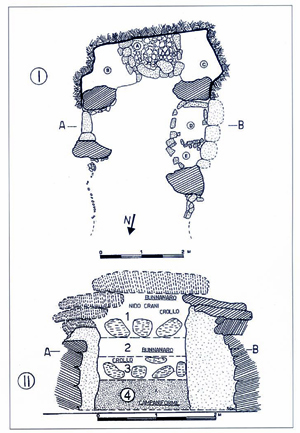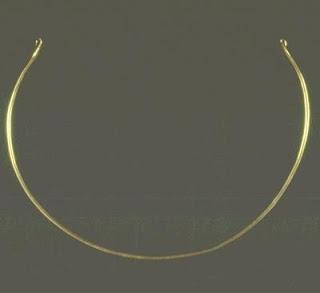La tomba di Bingia 'e Monti - Il Collier

La tomba preistorica di Bingia e Monti, famosa soprattutto per i ritrovamenti effettuati al suo interno nel corso dei recenti scavi, si colloca dal punto di vista tipologico a metà tra ipogeismo e megalitismo. Si compone infatti di un vano scavato nella roccia (A) e di una camera antistante costruita in tecnica megalitica (B), con quattro grossi blocchi angolari e pietre più piccole ai lati, mentre la copertura originaria era a piattabanda. La parte anteriore del monumento non si è conservata a causa della pendenza del terreno, quindi l'attuale lunghezza di 4,47 m. non corrisponde a quella originaria; l'altezza residua è invece di m 1,91.
Si tratta di una tomba collettiva utilizzata per un periodo di tempo molto lungo tra la fine dell'Età del Rame e il Bronzo Antico.
La fase più antica, corrispondente al vano scavato nella roccia si potrebbe attribuire alla Cultura di Monte Claro (metà III millennio a.C.), poichè nell'area sono stati rinvenuti anche i resti di un insediamento attribuibile a questa cultura. Nello strato più antico testimoniato dai ritrovamenti sono stati rinvenuti i resti ossei di vari individui e oggetti di corredo della cultura del Vaso Campaniforme (seconda metà del III millennio a.C.), queste sepolture più antiche erano sistemate all'interno di tre cassoni litici (a,b,c) addossati ai lati del monumento e coperti da un lastrone.
Al di sopra dei cassoni, oltre ad un ossario si rinvennero invece tre sepolture primarie, con scheletri completi e numerosi oggetti di corredoche oltre ai tipici vasi in ceramica della cultura campaniforme, tra cui bicchieri e tripodi, comprendevano anche ornamenti e gioielli. Tra i gioielli il più famoso è il collier d'oro, il più antico della Sardegna, ma furono rinvenute anche collane con vaghi in osso e bracciali da arciere, nonchè armi come pugnali in rame e punte di freccia. Dopo queste deposizioni la tomba non fu più utilizzata per un certo periodo, come indica lo strato di crollo rinvenuto al di sopra di esse.
Ad un periodo successivo appartengono i numerosi resti ossei sconnessi che al momento dello scavo si trovavano sopra il primo crollo. Nell'ultimo periodo di uso della tomba, corrispondente al Bronzo Antico e alla Cultura di Bonannaro (fine III-inizi II millennio a.C.) il monumento fu parzialmente risistemato e tra i blocchi furono deposti circa 50 crani di individui adulti coi loro corredi, che hanno permesso di datare quest'ultima fase. Gli oggetti rinvenuti nella tomba si trovano ora conservati al Museo Nazionale di Cagliari.

Bingia 'e Monti (Gonnostramatza, Oristano), tomba ipogeico-megalitica.
Collier in oro a verga piena di sezione tonda, a capi aperti, appiattiti e ricurvi.
Diam. 14 cm; spess. 0, 2, cm. Eneolitico Finale/Bronzo Antico.
Museo Archeologico Nazionale, Cagliari
Presso il Comune di Gonnostramatza, è presente la riproduzione dell'originale.
ARCHEOLOGY
THE TOMB OF BINGIA ‘E MONTI –THE NECKLACE
The prehistoric grave of Bingia ‘e Monti, which famous especially for the finds made inside during the recent excavations, is typologically dated between hypogeum age and the megalithic age. It is composed by a space excavated in the rock (A) and a chamber room built with megalithic technique (B), with four big angolar blocks and smaller stones on the sides, while the original cover was in piattabanda. The frontal part of the monument has not been preserved due to the slope of the area, so the current length of 4,47 meters does not correspond to the original one; the residual height is of 1,91 meters.
It is a collective tomb used for a long period between the end of the Copper Age and the Ancient Bronze Age. The most ancient phase, corresponding with the space excavated in the rock, can be attributed to the Culture of Monte Claro (half third millenium B.C.), this is due to the fact that in the area were found the remains of a settlement attributed to this culture. In the most ancient layers, findings of bones remains of various people and tomb goods of the Bell Beaker Culture testified the presence of the culture of Bell Beaker (second half of the III millennium), these most ancient burials were arranged inside three lithic boxes (a, b, c) leaned on the sides of the monument and covered by a big slab.
Above the boxes and in addition to an ossuary, tre primary burials were found containing entire skeletons and various tomb goods in addition to the typical ceramic vases of the Bell Beaker Culture, including glasses and tripods, as well as jewels and ornaments. Amongst the jewels, the most famous is the golden necklace, known to be the most ancient in Sardinia, but where found even necklaces with vague bones and archer’s bracelets as well as weapons such as copper daggers and arrowheads. After these depositions the tomb was no used for a period of time, as indicated by the layers of collapse found above them.
To a later period belong the numerous uneven bones’ remains that were found over the first collapse at the time of the excavation. In the last period of use of the tomb, which corresponds to the Ancient Bronze and the Culture of Bonannaro (end III - beginning II millennium B.C.), the monument was partially fixed, and more or less 50 adult skulls and their tomb goods were placed between the blocks: this permitted the dating of the last phase. Objects found in the tomb are now stored in the National Museum of Cagliari.
Bingia ‘e Monti (Gonnostramatza, Oristano), hypogeic-megalithic grave.
Necklace in gold full rod of round section with open, flattened and curved heads. Diameter 14 cm; thickness 0,2 cm. Final Eneolithic/Ancient Bronze.
National Archeological Museum, Cagliari.
It is possible to view the reproduction of the original necklace in Gonnostramatza City Hall.

